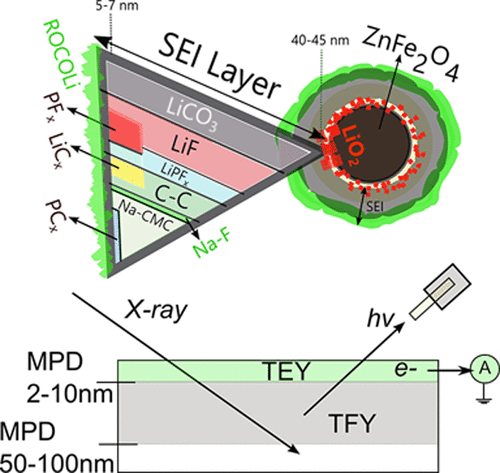当前位置:
X-MOL 学术
›
J. Phys. Chem. C
›
论文详情
Our official English website, www.x-mol.net, welcomes your
feedback! (Note: you will need to create a separate account there.)
SEI Dynamics in Metal Oxide Conversion Electrodes of Li-Ion Batteries
The Journal of Physical Chemistry C ( IF 3.3 ) Pub Date : 2017-11-17 00:00:00 , DOI: 10.1021/acs.jpcc.7b08259 S. J. Rezvani 1, 2 , F. Nobili 3 , R. Gunnella 1 , M. Ali 4 , R. Tossici 3 , S. Passerini 5, 6 , A. Di Cicco 1
The Journal of Physical Chemistry C ( IF 3.3 ) Pub Date : 2017-11-17 00:00:00 , DOI: 10.1021/acs.jpcc.7b08259 S. J. Rezvani 1, 2 , F. Nobili 3 , R. Gunnella 1 , M. Ali 4 , R. Tossici 3 , S. Passerini 5, 6 , A. Di Cicco 1
Affiliation

|
We examine the formation of the solid electrolyte interface (SEI) on anodes made of carbon encapsulated zinc ferrite (ZnFe2O4) nanoparticles (50 nm ZFO-C) as a standard metal oxide electrode prototype. The SEI formation and phase evolution are studied by two soft X-ray absorption techniques with different probing depths in the 10–100 nm range and by surface-sensitive X-ray photoemission spectroscopy at several specific capacities of the ZFO-C anodes. These techniques are shown to be able to provide information about the nature and extension of the individual chemical species within the SEI with a typical spatial resolution of 1–5 nm. A peculiar footprint of the interphase formations is obtained by comparing the chemical history of the reactive element sites in the anodes. The progressive development of the SEI in the first cycle and the variety of compositional transformations prior to stabilization are elucidated. Formation of a reversible alkyl carbonate layer, with maximum thickness of 7 nm, is detected at the SEI topmost region. On the basis of these results, we have obtained a map of suitable spatial resolution of the evolution of the different components of the interface layer.
中文翻译:

锂离子电池金属氧化物转化电极的SEI动力学
我们检查了由碳包封的铁酸锌(ZnFe 2 O 4纳米粒子(50 nm ZFO-C)作为标准的金属氧化物电极原型。通过在10-100 nm范围内具有不同探测深度的两种软X射线吸收技术以及ZFO-C阳极在几个特定容量下的表面敏感X射线光发射光谱学研究了SEI的形成和相演化。这些技术被证明能够以1–5 nm的典型空间分辨率提供有关SEI中单个化学物种的性质和扩展的信息。通过比较阳极中反应性元素位点的化学历史,可以获得相间形成的特殊足迹。阐明了SEI在第一个循环中的逐步发展以及稳定之前的各种组成转变。形成可逆的碳酸烷基酯层,在SEI最顶部区域检测到的最大厚度为7 nm。基于这些结果,我们获得了界面层不同组件演化的适当空间分辨率的地图。
更新日期:2017-11-20
中文翻译:

锂离子电池金属氧化物转化电极的SEI动力学
我们检查了由碳包封的铁酸锌(ZnFe 2 O 4纳米粒子(50 nm ZFO-C)作为标准的金属氧化物电极原型。通过在10-100 nm范围内具有不同探测深度的两种软X射线吸收技术以及ZFO-C阳极在几个特定容量下的表面敏感X射线光发射光谱学研究了SEI的形成和相演化。这些技术被证明能够以1–5 nm的典型空间分辨率提供有关SEI中单个化学物种的性质和扩展的信息。通过比较阳极中反应性元素位点的化学历史,可以获得相间形成的特殊足迹。阐明了SEI在第一个循环中的逐步发展以及稳定之前的各种组成转变。形成可逆的碳酸烷基酯层,在SEI最顶部区域检测到的最大厚度为7 nm。基于这些结果,我们获得了界面层不同组件演化的适当空间分辨率的地图。











































 京公网安备 11010802027423号
京公网安备 11010802027423号